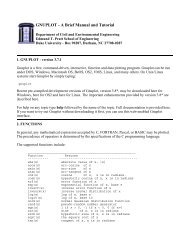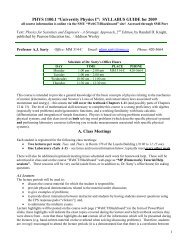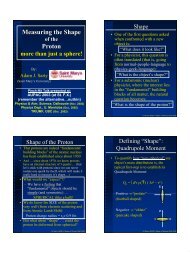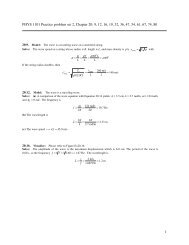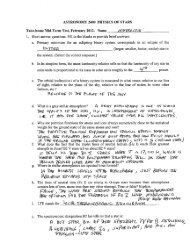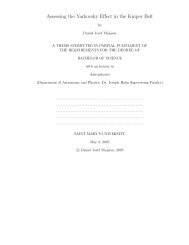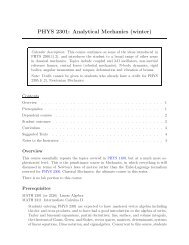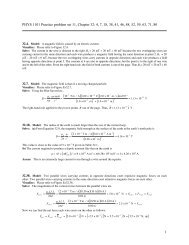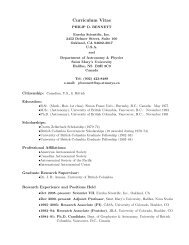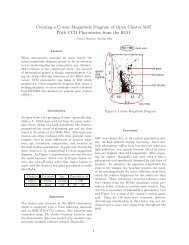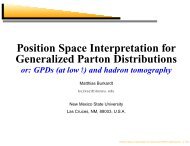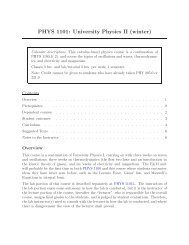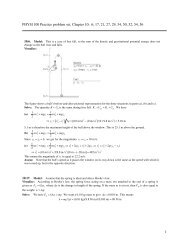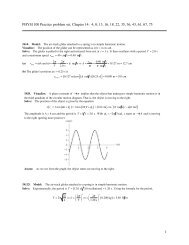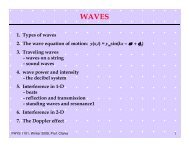the 10 MeV injector linac the new Building future plans
the 10 MeV injector linac the new Building future plans
the 10 MeV injector linac the new Building future plans
Create successful ePaper yourself
Turn your PDF publications into a flip-book with our unique Google optimized e-Paper software.
Status of <strong>the</strong> IASA<br />
Race Track Microtron Facility:<br />
<strong>the</strong> <strong>10</strong> <strong>MeV</strong> <strong>injector</strong> <strong>linac</strong><br />
<strong>the</strong> <strong>new</strong> <strong>Building</strong><br />
<strong>future</strong> <strong>plans</strong><br />
Andreas Karabarbounis<br />
UoA & IASA - Greece<br />
LOWq03 7-18-03<br />
http://www.iasa.gr
Layout of <strong>the</strong> talk<br />
• Presenting IASA<br />
• The <strong>10</strong> <strong>MeV</strong> <strong>injector</strong> <strong>linac</strong><br />
• Future <strong>plans</strong><br />
• The <strong>new</strong> building
The Institute of Accelerating<br />
Systems and Applications (IASA)<br />
An Autonomous Research Institute operating under <strong>the</strong><br />
auspices of <strong>the</strong> Ministry of Education.<br />
Participating Academic Units:<br />
The National & Capodistrian University of A<strong>the</strong>ns<br />
• School of Medicine<br />
• Department of Informatics<br />
• Department of Physics<br />
The National Technical University of A<strong>the</strong>ns<br />
• Department of Electrical & Computer Engineering<br />
• Department of Chemical Engineering<br />
• Department of General Science – Physics Division<br />
IASA http://www.iasa.gr
Brief Historical Background<br />
Aug – 94<br />
Jan – 95<br />
Jul – 95<br />
Sep - 95<br />
Nov -95<br />
Jan - 96<br />
Jun - 96<br />
Apr - 97<br />
Oct-97<br />
IASA Founded<br />
First managerial structure established<br />
NIST RTM disassembled and shipped to GR<br />
1st International Technical review<br />
Cascade Option chosen<br />
<strong>10</strong>0 keV Injector Maquette Launched<br />
U. of Illinois RTM Equipment shipped to GR<br />
First Beam out of <strong>injector</strong> Maquette<br />
Beneficial occupancy of Maquette <strong>Building</strong>
Oct-97<br />
Oct-98<br />
Nov-98<br />
Sep-99<br />
Oct-99<br />
Apr-02<br />
Nov-02<br />
Jun-03<br />
2nd International Technical review<br />
<strong>10</strong>0 keV Injector Maquette Completed<br />
Plans for a <strong>10</strong> <strong>MeV</strong> <strong>linac</strong><br />
Beneficial Occupancy of an Exp. Hall<br />
3rd International Technical review<br />
Upgrade to <strong>10</strong> <strong>MeV</strong> Maquette Initiated<br />
New building approved<br />
Excavations completed
Mission of <strong>the</strong> Institute<br />
To support Research and post graduate studies<br />
in all <strong>the</strong>matic areas where accelerators and<br />
related technologies play a role.<br />
• Nuclear & Particle Physics<br />
• Medicine<br />
• Materials Science<br />
• Informatics and Computer Science<br />
• Instrumentation<br />
• Archaeometry & Archaeological Preservation<br />
• Food preservation<br />
• Environmental Science
IASA will be an<br />
•open facility to researchers both<br />
Nationally and Internationally<br />
•a PAC governed user facility<br />
•need to have User Group meetings in<br />
order to find out Nuclear Physics<br />
community interests and priorities
Institutional and Geographical<br />
Facilities in Greece<br />
Setting<br />
• Several medical electron / proton Linacs<br />
• The “old” Tandem of “Demokritos”<br />
Regional Facilities<br />
• Nothing comparable in <strong>the</strong> Eastern Mediterranean<br />
Basin or <strong>the</strong> Balkan Peninsula<br />
• Nearest important facilities in Italy
International Links<br />
Formal Agreements with:<br />
• University of Illinois (USA)<br />
• Massachusetts Institute of Technology (USA)<br />
• Lomonosov - Moscow State University (RUSSIA)<br />
• Deutsches Electronen Synchrotron- DESY (Germany)<br />
• University of Sao Paolo (Brazil)<br />
• Yerevan University (Armenia)<br />
• The Joint Institute for Nuclear Research (Russia)<br />
• Jefferson Laboratory (USA)<br />
• Institute for Laser Plasma & Radiation Physics (Romania)<br />
Cooperation with:<br />
• Mainz (Germany)<br />
• Saclay (France)<br />
• Los Alamos National Laboratory (USA)<br />
• National Institute of Standards and Technology - NIST (USA)<br />
• CERN
Europe<br />
FYROM<br />
Greece
Greece<br />
ATHENS<br />
Santorini
Map of A<strong>the</strong>ns<br />
Center of<br />
A<strong>the</strong>ns<br />
NTUA<br />
Acropolis<br />
UoA Campus<br />
& IASA
One major task for IASA is building<br />
an electron accelerator
Microtron Variations<br />
• Classical Microtron<br />
• Double Sided Microtron<br />
(π-2)∆R=νλ<br />
• RaceTrack Microtron<br />
• Hexatron<br />
2π∆R=νλ<br />
(π/3-sinπ/3)2∆R=νλ
From Classical to<br />
RaceTrack Microtron<br />
MICROTRON CONDITION<br />
2π∆R = νλ<br />
d<br />
H<br />
MAGNETIC<br />
FIELD B<br />
LINAC<br />
MAGNETIC<br />
FIELD B
Mainz Microtron (MAMI)<br />
• 3 stage cascade microtron<br />
• Injection Energy = 3.5 <strong>MeV</strong><br />
• RTM1 = 14.4 <strong>MeV</strong> (18 recirculations)<br />
• RTM2 = 180 <strong>MeV</strong> (51 recirculations)<br />
• RTM3 = 855 <strong>MeV</strong> (90 recirculations)<br />
+<br />
MAMI C
So we finally adopted a :<br />
• 2 stage cascade CW RT Microtron<br />
• Injection Energy = 6.5 <strong>MeV</strong><br />
• RTM1 = 41 <strong>MeV</strong> (26 turns)<br />
• RTM2 = 240 <strong>MeV</strong> (25 turns)<br />
•RTM2 = 650 <strong>MeV</strong> (73 turns)<br />
•@<strong>10</strong>0 µA (max 650µA)<br />
Polarized source<br />
E. Stiliaris et al., Nucl. Phys. A 663(2000) <strong>10</strong>95c<br />
& IASA internal reports & CDR
Emittance<br />
Injection<br />
RTM1<br />
RTM2<br />
ε x = ε y < 2π mm mrad @ <strong>10</strong>0 keV measured<br />
ε tr = 0.1π mm mrad @ <strong>10</strong> <strong>MeV</strong><br />
ε L = 6.5π keV deg<br />
Eigenellipse in output orbit<br />
α =-1.02<br />
β = 0.27 deg/keV<br />
γ = 7.48 keV/deg<br />
Eigenellipse in output orbit<br />
α =-0.91<br />
(-0.91)<br />
β = 0.045 (0.012) deg/keV<br />
γ = 40.2 (88.4) keV/deg
The situation now…….<br />
• What we have<br />
(NIST & UIUC)<br />
• Linacs<br />
• RF – Klystrons (2)<br />
• End magnets (2 pairs)<br />
• Diagnostics<br />
• Magnets<br />
• Power supplies<br />
• Cooling<br />
• What we need<br />
• Spectrometers<br />
• Polarize source<br />
• Tagging facility<br />
• Vacuum equipment, magnets,<br />
power supplies eTc<br />
• Scattering chamber, cryogenics<br />
And ……<br />
• A <strong>new</strong> <strong>Building</strong>!!
In <strong>the</strong> meantime:<br />
we do occupy <strong>the</strong> so called<br />
“Maquette” building<br />
(~<strong>10</strong>00 m 2 )<br />
We are about to complete in this<br />
building an upgraded <strong>10</strong> <strong>MeV</strong> <strong>injector</strong><br />
5
University Campus<br />
1,5 km away from <strong>the</strong><br />
center of A<strong>the</strong>ns<br />
NTUA<br />
Maquette <strong>Building</strong>
IASA’s Maquette <strong>Building</strong>
<strong>10</strong> <strong>MeV</strong> Linac Layout (Present Status)<br />
Section AA’<br />
T-line<br />
Basement
RTM Injector<br />
• Thermionic Electron Gun [ <strong>10</strong>0keV (β=v/c=0.56) ]<br />
• Chopper - Buncher System<br />
• Capture Section (β-graded) [ 1.3 <strong>MeV</strong> (β=0.95) ]<br />
• Pre-Accelerator (few <strong>MeV</strong>, β~1)<br />
• Booster (4 m long <strong>10</strong>.5 <strong>MeV</strong>)<br />
C1<br />
C2<br />
e -<br />
E-gun<br />
B
<strong>10</strong>0-keV (Chopper-Buncher) Line
Beam diagnostics - Wire Scanners<br />
x
Capture Section & Pre-Accelerator<br />
Preaccelerator :<br />
2.7m, to 5 <strong>MeV</strong><br />
Eff. shunt imped.<br />
82.5 MΩ/m<br />
Preacc.<br />
Capt.<br />
Capture :0.9m to 1.2<br />
<strong>MeV</strong>, tapered β
The 4m Booster<br />
1,4MV/m<br />
@<br />
<strong>10</strong>.5 <strong>MeV</strong>
Energy and RF related parameters<br />
for <strong>the</strong> <strong>10</strong> <strong>MeV</strong> Maquette project<br />
Capture<br />
Preaccel.<br />
Booster<br />
Length (m)<br />
0.9<br />
2.7<br />
4<br />
Gradient (MV/m)<br />
1.6<br />
1.4<br />
1.4<br />
Dissipated RF (kW)<br />
27.9<br />
64.1<br />
95.0<br />
Beam RF (kW)<br />
0.14<br />
0.38<br />
0.54<br />
Total RF (kW)<br />
28<br />
65<br />
96<br />
Energy (<strong>MeV</strong>)<br />
1.3<br />
5.5<br />
<strong>10</strong>.5
EPICS @ IASA
RTM Control System Architecture<br />
EPAC –98
High power<br />
RF @ IASA<br />
500 kW CW<br />
2380 MHz Wave guides
RF @ IASA:<br />
Crowbar tests<br />
Ηλεκτρονικά<br />
Υψηλής Τάσης<br />
<strong>10</strong>0kV<br />
Αποµονωτής<br />
Ηλεκτρονικά<br />
Χαµηλής Τάσης<br />
High-speed<br />
Main disconnect
High Voltage tests<br />
• Successful operation of <strong>the</strong> 20/11<br />
kV transformer, alarms & interlocks<br />
• Successful operation of <strong>the</strong> VVT<br />
• Successful operation of <strong>the</strong> AC/DC<br />
Rectifier 55kV DC
RF tuning (control of temperature)<br />
Water out<br />
Water Manifold<br />
LO<br />
DBM<br />
RF<br />
IF<br />
Phase Shifter<br />
Directional Coupler<br />
RF Drive<br />
Cavity<br />
Cavity<br />
Sample<br />
Power<br />
Divider<br />
Directional Coupler<br />
Thermistor<br />
Manual set<br />
point T 0<br />
Temperature<br />
Control Unit<br />
Water in
Triode Valve<br />
e.g. <strong>10</strong>0 kW RF & 50 gpm
X [mm]<br />
<strong>10</strong> <strong>MeV</strong> CW-Linac<br />
(Beam Profile)<br />
Parmela simulation<br />
Z [cm]
Beam Transport to <strong>the</strong><br />
“Experimental Area”<br />
•Beam Optics Calculations (ptrace /<br />
Omen and Transport codes)
Transport<br />
System<br />
1 m<br />
Experimental “Hall”<br />
Two 135 o<br />
dipoles<br />
Energy analysis system
Optics of <strong>the</strong> beam transport system<br />
<strong>10</strong> <strong>MeV</strong> Exit line
“Experimental<br />
Area”<br />
PNC<br />
RREPS
Possible experiments<br />
(<strong>the</strong> Maquette building)<br />
• Study of <strong>the</strong> Parity Non-Conserving<br />
Force between Nucleons through<br />
Deuteron Photodisintegration<br />
• Study of novel sources of Radiation<br />
from Relativistic Electrons in<br />
Periodic Structures (RREPS)<br />
PNC<br />
<strong>10</strong><br />
RREPS
Study of <strong>the</strong> Parity Non-Conserving Force between<br />
Nucleons through Deuteron Photodisintegration<br />
Experimental Goal<br />
Reduce <strong>the</strong> systematic errors to a better level than <strong>10</strong> -7<br />
for <strong>the</strong> neutron asymmetry Az in <strong>the</strong> reaction<br />
γ + d p + n E(γ) = 3 – 8 <strong>MeV</strong><br />
What is needed ?<br />
‣ A polarized photon beam<br />
‣ An improved n-detection n<br />
system<br />
‣ Beam quality and stability with quick feed back system
The Proposed Experiment<br />
Detector Set Up (schematically) for <strong>the</strong> d(γ,n)p reaction<br />
e<br />
Au<br />
Lead Shield<br />
Heavy Water<br />
LD 2<br />
Neutron & Photon<br />
Detectors<br />
Letter-of<br />
of-Intent<br />
JLAB<br />
LOI-00<br />
00-002002 for PAC 17<br />
Compton<br />
Detector<br />
Forward Photon Detector<br />
50 cm<br />
Photon Beam Dump
Radiation from Relativistic Electrons<br />
from Periodic Structures (RREPS)<br />
e - beam<br />
e.g. a Smith-Purcell<br />
experiment (layout),<br />
PXR or Channeling<br />
grating<br />
Detector<br />
Vacuum Chamber<br />
To beam dump
Future <strong>plans</strong> :<br />
• Commissioning of <strong>the</strong> <strong>10</strong> <strong>MeV</strong><br />
machine – <strong>10</strong> <strong>MeV</strong> beam tests<br />
• Full occupation of <strong>the</strong> experimental<br />
areas<br />
• Beginning of experiments (04)<br />
and in <strong>the</strong> meantime<br />
Full occupation of <strong>the</strong> <strong>new</strong> <strong>Building</strong> (05)
Research Program<br />
Pure recearch program is still an<br />
open issue *<br />
Applied research program has more<br />
shape<br />
Lets give some first ideas about it…
Applied Research Program<br />
• Advanced Medical Imaging techniques<br />
• Research on radiation <strong>the</strong>rapy<br />
• Photonuclear reactions for production of<br />
short-lived isotopes<br />
• Food Irradiation<br />
• Irradiation effects on Advanced Materials<br />
• Novel sources of Radiation from Relativistic<br />
electrons over periodic Structures (Smith-<br />
Purcell, PXR, Channeling etc) - RREPS
•Archeological preservation (icons)<br />
•Wastewater treatment<br />
•Air quality applications<br />
•Surface water and Marine environment<br />
Accelerator research and development<br />
•Free Electron Laser (FEL) applications<br />
•Polarize electron source<br />
•Tagging facility
e.g. Medical Imaging<br />
( 99m Τc-MDP)<br />
PSPMT Camera
The <strong>new</strong> building…<br />
New<br />
<strong>Building</strong><br />
IASA
The site of <strong>the</strong> New building<br />
(excavation already completed*)<br />
* End of June 03
IASA : The Cascade cw RTM’s<br />
(PHASE 3)<br />
EXP. AREA<br />
650 <strong>MeV</strong><br />
Basement<br />
RTM2<br />
(PHASE 2)<br />
INJ. LINE<br />
RTM1<br />
RTM1 (PHASE 1)
Summary<br />
• The <strong>10</strong> <strong>MeV</strong> <strong>injector</strong> almost completed<br />
• The <strong>new</strong> building started<br />
• Following <strong>10</strong> <strong>MeV</strong> beam tests : “experiments”<br />
• Expect energies up to 40 <strong>MeV</strong> (phase 1) and<br />
<strong>the</strong>n up to 240 <strong>MeV</strong> (phase 2)<br />
• Current typical <strong>10</strong>0 µA<br />
• Very good emmitances<br />
• ∆E/E less than <strong>10</strong> -4 (B & RF)<br />
• Start with two experimental halls<br />
• We will have a polarized electron source<br />
• Tagging facility<br />
• Possible upgrade to 650 <strong>MeV</strong> (phase 3)
IASA Team<br />
• Dimitris Baltadoros<br />
• Samuel Cohen<br />
• Dimitris Economou<br />
• Tasos Filippas<br />
• Tassos Garetsos<br />
• Evangelos Gazis<br />
• Athanasios Geranios<br />
• Nikos Giokaris<br />
• Giannis Grammenos<br />
• Andreas Karabarbounis<br />
• Christos Ktorides<br />
• Frantzeskos Maravelias<br />
• Kaliopi Marini<br />
• Nikos Papadakis<br />
• Costas N Papanicolas<br />
• Vicky Phinou<br />
• Paris Sphicas<br />
• Stathis Stiliaris<br />
• Sotiris Sotiropoulos<br />
• Nikos Uzunoglou<br />
www.iasa.gr



